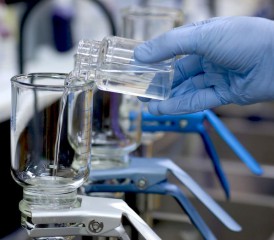Is the Asbestos in Our Drinking Water Dangerous?

Lately, I’ve been complaining about three things: The taste of tap water where I live, money I spend on bottled water and the unnecessary amount of plastic bottles I go through.
In order to cut costs and waste, my girlfriend and I decided to buy a water bottle equipped with a filter. We figured it would improve the taste of our tap water, and we’d probably save money in the long run – as well as drinking cleaner water.
While reading the list of insecticides, chemicals and other dangerous substances removed from tap water by a popular brand of filtering water bottles, it surprised me to see asbestos in that listing of impurities.
Asbestos is a naturally occurring mineral known to cause serious medical conditions like malignant mesothelioma, asbestosis and asbestos lung cancer, among other diseases. Doctors diagnose around 3,000 new cases of mesothelioma annually.
My stepfather, Jeff Wahl, died of mesothelioma in October 2011 after fighting the cancer for seven months. Learning that tap water contained asbestos angered me because for a moment I thought, “Could tap water have contributed to his diagnosis?”
After some research, federal regulatory agencies have determined the minimal amount found in drinking water probably didn’t lead to his diagnosis, but what I learned still surprised me.
Traces of Asbestos in Our Drinking Water
Industrialized nations used asbestos heavily between 1930 and 1970, primarily in the construction of new houses and buildings. The U.S. military used the mineral in the building of its ships, too. The toxic substance also was found in insulation, ceiling and floor tiles and other products used in close proximity to people.
But tap water? How could that be?
The U.S. Environmental Protection Agency shows asbestos was used in the cement pipes that distribute water to communities across the country.
As our water mains decay and natural deposits erode over time, they release asbestos fibers into our drinking water. In addition to causing mesothelioma, the EPA shows long-term exposure to asbestos above the maximum contaminant level of 7 million fibers per liter (MFL) also can increase the risk of developing benign intestinal polyps.
Congress in 1974 passed the Safe Drinking Water Act which requires the regulation of our drinking water. The EPA is the agency that regulates and screens our water for dangerous impurities. In 1992, EPA officials added asbestos to the list of 90 contaminants often found in our water.
Water treatment plants remove asbestos from drinking water using coagulation/filtration, direct and diatomite filtration and corrosion control, the EPA shows.
A 2003 World Health Organization report using updated data from the Centers for Disease Control and Prevention, “Asbestos in Drinking Water,” indicates that “most of the population of the USA consumes drinking water containing asbestos in concentrations below 1 MFL.” That is well below the EPA’s standards and likely wouldn’t cause health problems.
In the case asbestos levels rose above the maximum allowed, water suppliers would be required to notify customers no later than 30 days after the violation is noticed.
If you are curious about what’s in your drinking water, contact your water supplier for their annual water quality report. The EPA also publishes reports about drinking water violations.
Importance of Drinking Water
I strongly encourage you to drink about a gallon of water daily, especially if you’re exercising. This amount ensures you will not become dehydrated or experience any side effects of dehydration.
I also understand this amount may not be realistic for some people undergoing treatment for mesothelioma. I remember Jeff being so sick at times that he couldnt ingest anything – even water.
But it’s still important to keep hydrated. Signs of dehydration include headaches, muscle twitches or tiredness. These can also intensify the side effects of a chemotherapy and radiation treatment.
Dehydration also has a negative effect on your workouts whether youre fighting mesothelioma or playing the role of a caregiver. I always encourage my clients to never ask for water, instead drink it as they feel necessary.
After everything I learned about asbestos in drinking water, regardless of the minute traces, I recommend drinking filtered water from a sealed water bottle, filtered faucet or a filtered pitcher.
You should be drinking the best quality water.
Drink up and remember to Never Give Up.